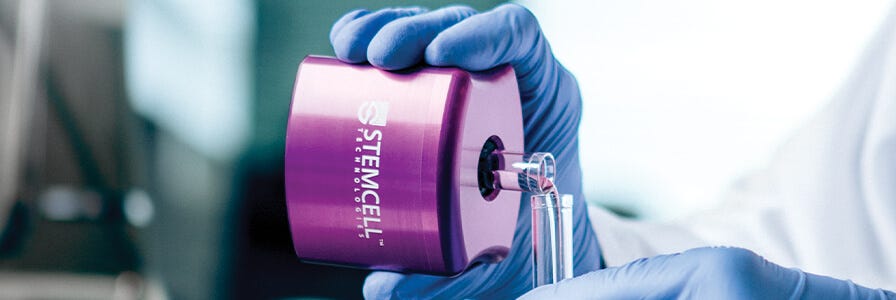How to Isolate Mouse Peritoneal Cells
This protocol describes how to collect mouse peritoneal cells in preparation for downstream isolation of specific target cells.
Materials
- EasySep™ Buffer (Catalog #20144)
- 25 gauge and smaller gauge (e.g. 18G to 23G) needles
- 6 mL syringes
- 50 mL Falcon® Conical Tubes (Catalog #100-0090) or 15 mL Falcon® Conical Tubes (Catalog #100-0092)
- Sterile blunt-end autoclavable scissors
- Forceps
Protocol
- Euthanize mice as per your institutional guidelines.
- Pin the mouse down by each foot to a dissection board.
- Spray down the abdomen with 70% ethanol or isopropyl alcohol.
- Use forceps to pull the skin up above the sternum and make an incision along the midline with sterile blunt-end scissors. Be careful not to pierce the peritoneum.
- Pull the skin away to fully expose the peritoneum.
- Attach a 25 gauge needle to a 6 mL syringe and fill the syringe with 5 mL of cold EasySep™ Buffer (or Ca+2 and Mg+2 free PBS with 2% FBS and 1 mM EDTA).
- With the beveled side facing away from the mouse, insert the needle through the peritoneal wall at the lower quadrant of the abdomen at a ~10 degree angle and almost parallel with the vertebral column. Avoid puncturing internal organs.
- Inject 5 mL of EasySep™ Buffer.
- Unpin the mouse and shake and invert the mouse several times to mix the buffer throughout the peritoneal cavity. Alternatively, massage the inflated peritoneal cavity for at least 30 seconds.
- Attach a smaller gauge needle to a new syringe.
- If applicable, pin the mouse down again. With the beveled side facing away from the mouse, insert the needle into the inflated peritoneal cavity at the lower quadrant of the abdomen and move the needle away from intestines and fat deposits to prevent the needle from being blocked. Slowly aspirate the peritoneal fluid.
- Remove needle from syringe and dispense the peritoneal fluid into a 50 mL Falcon® Conical Tube (Catalog #100-0090) or a 15 mL Falcon® Conical Tube (Catalog #100-0092) when processing a smaller number of mice.
- Centrifuge at 300 x g for 10 minutes at room temperature with the brake set on low (i.e. deceleration set at 1 - 2).
- Carefully remove and discard the supernatant without disturbing the cell pellet.
- Resuspend cells in recommended medium* at the required cell concentration for your downstream procedure.
*EasySep™ Buffer (or Ca+2- and Mg+2-free PBS with 2% FBS and 1 mM EDTA) if further isolation with an EasySep™ kit will be performed.
Request Pricing
Thank you for your interest in this product. Please provide us with your contact information and your local representative will contact you with a customized quote. Where appropriate, they can also assist you with a(n):
Estimated delivery time for your area
Product sample or exclusive offer
In-lab demonstration




